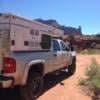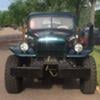Here is my factory weight tag, still attached to my 1976 Alaskan 8 Foot Cabover camper...

That is 1450 lbs with 20 gallons of water and 25 lbs of ice on board.
Plain Icebox, no heater, no toilet. Stove but no oven.
My1988 F-250 Lariat HD 4x4 (extended cab, two doors) clocks in with me and both tanks full at:
GAWR (Front) = 3520
GAWR (Rear) = 2860
GVWR (Both) = 6400
My VIN tag says:
GAWR (Front) = 3920
GAWR (Rear) = 6084
GVWR (Both) = 8800
So it appears I can SAFELY....accommodate 400 lbs more on the FRONT axle and 3224 lbs more on the REAR axle.
Basically I can just about carry TWO Alaskans with this truck without my camping gear in it, at least on the rear axle!
The reason for the disparity in what my truck can handle on the front compared to the rear is due to the 460 cu. in. motor, the C6 auto trans and the 4X4 on board.
When I went to pick up this Alaskan, I couldn't really tell any difference in performance or braking issues but I would expect when it is loaded for bear (so to speak) to go to the Sierras, it will not be flying UP those grades! However, it never did even with just a camper shell of about 200 lbs or so mounted on it.
Do your weight estimates for each camper before purchasing, but get "enough truck" by all means.
The standard rap on the Alaskans is "but they are too HEAVY!" which is true when you ain't got enough truck in the first place!
However, modern units from all three mfgers can carry about the same stuff in them as they are custom built. I like having some aluminum and plywood between me and the Great Outdoors, especially in "Bear Country" as vinyl isn't much of a deterrent to a hungry one. Personal style issues and costs may influence you also...
"It's YOUR wallet!"






















